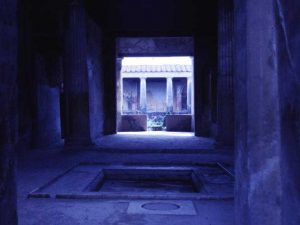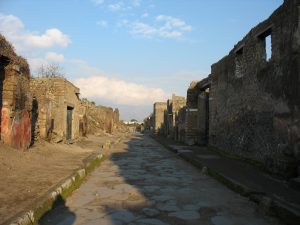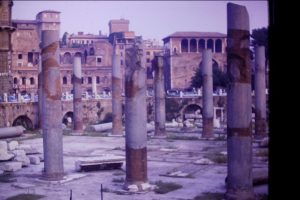In Part I, we examined some recent research on Pompeii, focusing on archaeological studies. Here we will look at British scholar Peter Oakes’ 2009 book, Reading Romans in Pompeii: Paul’s Letter at Ground Level, which combines archaeological insights from Pompeii with an exegesis (analysis) of important aspects of St. Paul’s letter to the Romans.
St. Paul and His Authentic Letters
As we have seen many times before, St. Paul is a paramount figure in the history of Christianity. ![]() Paul, a Jew from Tarsus in what is now Turkey, initially persecuted people who followed Jesus of Nazareth in the early first century of the Common Era (CE) but then became one of the Jesus movement’s champions, especially to non-Jews (Gentiles). We know about Paul primarily from letters attributed to him in the New (Christian) Testament of the Bible (NT) and through the non-historical NT book, the Acts of the Apostles.
Paul, a Jew from Tarsus in what is now Turkey, initially persecuted people who followed Jesus of Nazareth in the early first century of the Common Era (CE) but then became one of the Jesus movement’s champions, especially to non-Jews (Gentiles). We know about Paul primarily from letters attributed to him in the New (Christian) Testament of the Bible (NT) and through the non-historical NT book, the Acts of the Apostles.
Paul’s legacy is surrounded by controversy, in part because several of the NT letters attributed to him are actually pseudepigraphical – designated “of Paul” but actually written many years after his death in about 65 CE. The difference between the authentic and inauthentic letters is significant, not only because there are theological differences between them but also because Paul has historically been seen as anti-woman: statements in the pseudepigraphical letters suggest that Paul suppressed women (which has had horrendous ramifications for women for centuries), but his authentic letters show that he actually greatly respected women – who held leadership roles in the communities of the early Jesus followers.
Mainstream scholarship designates the following letters as truly written or dictated by Paul between about 50 and 60 CE: Romans, I Corinthians, II Corinthians, Galatians, Philippians, I Thessalonians, and Philemon. Of these, Romans is the longest and the most fleshed-out doctrinally. Because so much has been written about Paul, the NT writings, and other early Christian literature for over 150 years, it is significant that Oakes has offered a refreshing new way to examine Romans – by using archaeological evidence from domestic spaces in Pompeii to flesh out early Christian house churches and their members.
The Living and Working Spaces of Pompeii
 Oakes begins by describing a block of houses that have been excavated in Pompeii. Block I.10, actually an “insula,” a “block of houses surrounded by streets,” is known by many as the famous House of Menander. The spaces in this insula are incredibly small, for the most part; the size starts to give us an idea of how our forebears in the faith actually lived day by day. The term “house” thus is probably generous but normative.
Oakes begins by describing a block of houses that have been excavated in Pompeii. Block I.10, actually an “insula,” a “block of houses surrounded by streets,” is known by many as the famous House of Menander. The spaces in this insula are incredibly small, for the most part; the size starts to give us an idea of how our forebears in the faith actually lived day by day. The term “house” thus is probably generous but normative.
Oakes focuses his attention on certain portions of this insula, starting with Houses 6-7. House 6, Oakes postulates, was probably occupied “by slaves or freed slaves from the House of the Menander,” more likely by freed slaves (page 10). (The House of Menander is “named after a helpfully labelled painting of the poet” in an alcove in the house [page 37]). Oakes gives a name and occupation to the possible resident of House 6, as well as some important demographic information: Sabina is a freed female slave (who continues to be indebted to her former owner), she has a husband, and they are stoneworkers. They do not have children that live with them, although they may have had children earlier in their lives. This couple is “not far from destitution,” so Sabina “represents the social type of a very poor, female Christian craftworker” (page 11).
House 7 in this insula, which has several small rooms, yielded a number of loose finds that help archaeologists determine the usage of the rooms.  There was a kitchen, a garden, a multi-use space, and rooms upstairs that had collapsed. From the evidence, Oakes surmises that this space was used by a cabinet-maker whom he names Holconius. This man most likely rented the house and had “the closest relationship with [its] cultural artefacts” (page 32), such as domestic items, woodworking tools, and even medical instruments.
There was a kitchen, a garden, a multi-use space, and rooms upstairs that had collapsed. From the evidence, Oakes surmises that this space was used by a cabinet-maker whom he names Holconius. This man most likely rented the house and had “the closest relationship with [its] cultural artefacts” (page 32), such as domestic items, woodworking tools, and even medical instruments.
Next Oakes looks at Houses 2-3 and 4 in the insula. House 2-3 contains three pieces of graffiti, which help elucidate the nature of the space and its resident. (House 2-3 has two numbers because the original archaeologists, before they had more evidence, thought that there were two doorways instead of one [page 1]). The graffiti mentions the innkeeper’s servant girl, with the name of Iris, and a weaver nearby who loves her. Thus we see that “House 2-3 is a bar linked to the small two-storey house” and Iris the slave girl belonged to the (female) bar owner (page 34).
This overview of just a few portions of the insula begins to illustrate the basics of the economic situation of the non-elite of Pompeii (and thus of other cities in the Roman Empire):
“The owner of the house [of Menander] was probably senatorial. However, the inhabitants of the house were mainly slaves. The great majority of people who lived in elite houses were themselves non-elite” (page 39).
So, looking at Oakes’ “characters,” “[t]he inhabitants of House 2-3 [the barmaid and her owner] were better off than the stoneworkers [Sabina and her husband] but less well off than the cabinet-maker [Holconius].”
There is finally one more likely person to consider in Oakes’ narrative – Primus the bath-stoker. He would have been a middle-aged slave in a practically invisible job. This job would most likely never have led to his being freed by his owner, as some other positions may have been.
These figures – our hypothesized members of the house church hearing Paul’s letter to them – will return later in Oakes’ study as examples of early Jesus followers who met in a house-church setting. This is the crux of Oakes’ thesis.
Houses and First-Century Society
Oakes continues his analysis by examining the archaeological record, especially around living and working spaces, and how that record sheds light on life in the Mediterranean area in the first century of the Common Era (CE), the time of Jesus, his contemporaries, his earliest followers, St. Paul, and the earliest Christian communities. The following traits pertain to Holconius the cabinet-maker and his home (pages 44-45):
- This house takes up eight times as much land as the stoneworkers’ house (that of Sabina and her husband).
- There may also have been an upstairs, which makes the space even larger.
- This cabinet-maker/craftworker and others like him “could have space to host a meeting of a fair-sized house church. Forty or so people could fit into the garden, portico and rear-facing dining rooms,” even though attendees were probably stepping over tools and projects.
- Holconius may have been a client to his elite landlord next door as well as a patron to some craftworkers who were less well-off financially than he was.
Oakes cites a number of scholars who have long conducted research on house size, income distribution, social structure and related issues in the early Roman Empire in order to pin down more precisely the nature of these house-church communities. Oakes’ work is very valuable to NT studies, in part because he is able to correct several erroneous assumptions that have been made about the earliest church members.  For instance, when early church historians now look at Paul’s colleagues Prisca/Priscilla and Aquila, referenced several times in the NT, we can be better informed and more specific as to these early Christians’ economic situation. This couple were most likely craftworking house-church hosts, and we can actually point to physical examples of such a house in which they might have met. They were not what we would consider middle-class Christians in a nice American suburban neighborhood, nor were they slaves with almost no agency. We shall see more of these differences and their significance in our conclusions, below.
For instance, when early church historians now look at Paul’s colleagues Prisca/Priscilla and Aquila, referenced several times in the NT, we can be better informed and more specific as to these early Christians’ economic situation. This couple were most likely craftworking house-church hosts, and we can actually point to physical examples of such a house in which they might have met. They were not what we would consider middle-class Christians in a nice American suburban neighborhood, nor were they slaves with almost no agency. We shall see more of these differences and their significance in our conclusions, below.
Oakes’ Exegesis of Romans 12
NT scholars are trained in “exegesis,” that is, in-depth analysis of NT texts (and the Bible in general). Oakes takes the archaeological evidence from Pompeii and reasonably transfers it to Rome, a much larger city; the one major difference is that in Rome the house church would probably number only 30 individuals, not 40 (pages 95-96).
 Oakes then moves into an exegesis of Rom 12, imagining it as if heard by a “motley crew” of house-church members. Only a short summary can be attempted here; a complete read is highly recommended.
Oakes then moves into an exegesis of Rom 12, imagining it as if heard by a “motley crew” of house-church members. Only a short summary can be attempted here; a complete read is highly recommended.
- Rom 12:1-2. A communal living sacrifice (pages 99-100)
- Rom 12:3. A new scale of value (pages 100-02)
- Rom 12:4-5. Symmetrical relationships in Christ across household boundaries (pages 102-04)
- Rom 12:6-8. The diverse gifts that make a house church work (pages 104-06)
- Rom 12:9-10a. Family love beyond family boundaries (pages 107-110)
- Rom 12:10b. Mutual honouring in a hierarchical world (pages 110-12)
- Rom 12:11. Hard work (pages 112-13)
- Rom 12:12. Hope, endurance and prayer (pages 113-15)
- Rom 12:13. Giving and hospitality (pages 115-18)
- Rom 12:14. Bless, rather than curse, your persecutors
- Rom 12:15-16. Family sympathy beyond family boundaries; involvement with the poor (pages 119-23)
- Rom 12:17-21. Against Christian retributive violence (pages 123-26)
Just this cursory look at Oakes’ descriptive phrases speaks volumes. Paul covers a tremendous amount of territory – not just theological but also relating to real life – that broadens and deepens our understanding of the earliest Jesus followers in the first century. Paul offers hope, love, community and advice to people at or very close to the bottom of society. Even though the house-church members would have experienced both sacrifice and non-conformity, there is almost no getting around the revolutionary and earth-shaking nature of Paul’s overall message: liberation, equality and justice at levels that would have been practically unimaginable to the letter’s hearers.
Romans as Understood by House-Church Members
After this initial exegesis of one chapter of Romans, Oakes examines Paul’s larger message in Romans from the standpoint of his four exemplars: Primus, Sabina, Iris and Holconius.  (Oakes adds that other slaves and perhaps homeless people would also have been members of this early Christian community.) This is the meat of Oakes’ analysis and a fascinating window into the possible members of the Jesus gatherings in first-century cities.
(Oakes adds that other slaves and perhaps homeless people would also have been members of this early Christian community.) This is the meat of Oakes’ analysis and a fascinating window into the possible members of the Jesus gatherings in first-century cities.
Primus. According to Paul, the gospel – good news – that comes from having trust in Jesus the Christ was closely tied to justice, a major concern of someone at the bottom of the social ladder like Primus the slave. Recent studies of the ancient world have shown that slavery came not only with drudgery but also with sexual exploitation. Oakes clearly describes how Paul’s message would have resonated with Primus and others like him:
“God’s justice needed to have two sides. It needed to bring down those who oppressed Primus. It also needed to raise him up. . . . Paul’s idea of salvation effectively gave everyone equal status” (page 135). Looking specifically at Rom 6:15-23, everyone becomes morally responsible. “For Primus, to be told that he was a son of God was staggering. This put his status above the whole of society” (page 136).
“For a slave, any adoption was a sharp increase in status. It could only come with freedom” (page 137).
Sabina. For Sabina, the freed slave and stoneworker who was still beholden to her former owner, a major daily concern would have been mere survival. She and her husband would have received little help from anyone. As Oakes points out, “they would probably either have paid their patron a significant sum of money for their freedom or have been freed when they reached an age at which their economic value became marginal” (page 138). Paul’s message of endurance and hope (in Rom 8, for instance) would have resonated well with this segment of the population. Help for their dire situation would have come from the Holy Spirit – a “very active, palpable force in the believer’s life” (page 140), not an obscure theological concept.
What’s more, endurance in this life is closely related to the hope of eternal life. Oakes rightly questions why, traditionally, NT scholars have downplayed this aspect of Paul’s message – and that aspect of Christianity, for that matter.  Paul speaks of the afterlife, immortality, resurrection or eternal life several times in Romans: 2:7, 2:10, 4:17, 4:24, 5:2, 5:10, 5:21, and 6:23. For Sabina, whose life in this world was precarious, frightening, extremely difficult and miserable, the promise of a blissful afterlife with Jesus would have been welcome indeed.
Paul speaks of the afterlife, immortality, resurrection or eternal life several times in Romans: 2:7, 2:10, 4:17, 4:24, 5:2, 5:10, 5:21, and 6:23. For Sabina, whose life in this world was precarious, frightening, extremely difficult and miserable, the promise of a blissful afterlife with Jesus would have been welcome indeed.
Iris. Iris’ story is one of a person who has virtually no control over her own body. Her “job” as the bar owner’s servant girl would, in large part, have entailed flirting with customers and prostituting herself. Oakes argues that Iris and others like her would have experienced “cognitive dissonance” in their lives: being “compelled to action that Christian teaching saw as sinful” (page 145). What Paul offers her is a rebirth of sorts that gives her a new identity of “worth and integrity, that was essentially hidden from her owner” (page 145). Ironically, the tips that Iris made may have allowed her to support the Christian mission financially to a higher degree than others.
As with Sabina, Iris may have been able to take comfort in the hope of a future eternal life that would free her from her life of suffering and enslavement to others’ dictates and whims.
Holconius. Finally we come to the host of the house church, Holconius the cabinet-maker. Holconius would have been a new Christian with some knowledge of Judaism (to which Paul refers a fair amount in Romans) who felt a certain level of responsibility for the well-being of the group. Hearing Romans, Holconius may have had conflicting reactions toward Judaism and Jewish ways: glad that he would not be required to undergo circumcision (!) and that the God of the Jews could also be his God, while perhaps being confused by Jewish laws and also perhaps prejudiced against Jews, as so many others were.
Paul’s words about a “holy people” (Rom 1:7, 8:27, 16:2, 15) would have shocked Holconius to some extent: holiness and specialness in the ancient world was for those who had close proximity to the divine, such as Vestal Virgins, not the “ragbag of craftworkers, slaves, men, women, children, young, old, modestly well off, destitute” (page 164) in his house church. The holy ones – all of them, no matter their status as defined by the world – were called to be “in good moral standing with God and as being morally responsible” (page 172). In other words, in the early Christian house church, each individual was not only special and valuable in God’s eyes but also called to be responsible for each other.
Conclusions and Significance
Peter Oakes provides a wide array of thinking creatively – based on evidence – not only about the earliest members of the Jesus movement but about ourselves as Christian and, yes, Western inheritors of that heritage. Whether we like or admit it or not, and for better or worse, we in the West live with the remnants of early Christianity. This makes it all the more important for us to understand as well as possible the reality of those ancestors’ real lives; in some ways, those ancestors were similar to us in the 21st century, but in many ways they were different. How can knowledge of our similarities and differences contribute not only to our own self-understanding but also to liberation, justice and equality in contemporary society?
Justice.  As Oakes asserts in the discussion about Primus the slave, “For most people in the world, the need for justice is probably a bigger perceived issue than the need for forgiveness” (pages 132-33). The unjust nature of normal life in the ancient world is almost incomprehensible to most relatively comfortable Westerners. We may not be in the dire straits of a Primus, who would find great comfort in Paul’s message, but we can surely think about the people throughout today’s world – including in our own rich nation – who could use some real justice. Even if we are not Christians, we are descendants of early Christians, and one of the basic tenets of Western nations is “justice.” What does that truly mean for people at the lowest levels of our societies? What are our responsibilities toward bringing justice about?
As Oakes asserts in the discussion about Primus the slave, “For most people in the world, the need for justice is probably a bigger perceived issue than the need for forgiveness” (pages 132-33). The unjust nature of normal life in the ancient world is almost incomprehensible to most relatively comfortable Westerners. We may not be in the dire straits of a Primus, who would find great comfort in Paul’s message, but we can surely think about the people throughout today’s world – including in our own rich nation – who could use some real justice. Even if we are not Christians, we are descendants of early Christians, and one of the basic tenets of Western nations is “justice.” What does that truly mean for people at the lowest levels of our societies? What are our responsibilities toward bringing justice about?
Afterlife. It is refreshing that Oakes has criticized traditional NT scholarship for ignoring Paul’s references to the afterlife. There are probably several reasons, some of them justified, for this neglect. Mainstream NT scholars have tended to focus on the social justice aspects of the gospel – the necessity in this physical life to work on the part of the oppressed and downtrodden. Scholars with a more “liberal” bent have shied away for over a century from dealing with NT issues around life after death. Their preferred focus is not incorrect; as we have seen, social justice looms large in the early Christian message.
However, more liberal scholars’ neglect of the afterlife is perhaps an overreaction to the Fundamentalist Christian focus on the saving of souls in order that those souls go to heaven at death and not hell. Oakes shows that responsible NT scholarship, when examining the authentic letters of St. Paul, can focus on both life in the physical world and concerns with social justice AND the appeal of a glorious afterlife. The attraction of a blissful existence after death for millions of oppressed people around the world should not be minimized, ignored or disparaged.
Diversity and community. Finally, Oakes describes early Christian communities as diverse in many ways, although perhaps lacking people at the highest echelons of society. Certainly the rich and privileged are welcome to Christian communities – but they must realize that the “good news” may be difficult for them to hear.  They will be asked to treat their fellow members as equals and to be themselves morally upright and responsible. They will be asked not to exploit another’s body; and they will be encouraged to help the active, tangible Holy Spirit lead them and their efforts in ways that serve the group as a whole, not their own interests alone.
They will be asked to treat their fellow members as equals and to be themselves morally upright and responsible. They will be asked not to exploit another’s body; and they will be encouraged to help the active, tangible Holy Spirit lead them and their efforts in ways that serve the group as a whole, not their own interests alone.
A diverse community united around messages of hope, common interests, justice and equity is surely one that offers truly good news for all. Let us offer our gratitude to Professor Peter Oakes for elucidating this truth from a creative, evidence-based and cross-disciplinary perspective.
Resources
Oakes, Peter. Reading Romans in Pompeii: Paul’s Letter at Ground Level. London: SPCK and Minneapolis: Fortress Press, 2009.

